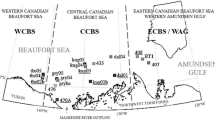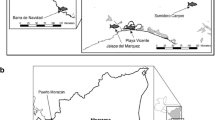Abstract
Recent studies have shown that the complementary analysis of mercury (Hg) concentrations and stable isotopic ratios of nitrogen (δ15N) and carbon (δ13C) can be useful for investigating the trophic influence on the Hg exposure and accumulation in marine top predators. In this study, we propose to evaluate the interspecies variability of Hg concentrations in phocids from polar areas and to compare Hg bioaccumulation between both hemispheres. Mercury concentrations, δ15N and δ13C were measured in fur from 85 individuals representing 7 phocidae species, a Ross seal (Ommatophoca rossii), Weddell seals (Leptonychotes weddellii), crabeater seals (Lobodon carcinophagus), harbour seals (Phoca vitulina), grey seals (Halichoerus grypus), ringed seals (Pusa hispida) and a bearded seal (Erignathus barbatus), from Greenland, Denmark and Antarctica. Our results showed a positive correlation between Hg concentrations and δ15N values among all individuals. Seals from the Northern ecosystems displayed greater Hg concentrations, δ15N and δ13C values than those from the Southern waters. Those geographical differences in Hg and stable isotopes values were likely due to higher environmental Hg concentrations and somewhat greater number of steps in Arctic food webs. Moreover, dissimilarities in feeding habits among species were shown through δ15N and δ13C analysis, resulting in an important interspecific variation in fur Hg concentrations. A trophic segregation was observed between crabeater seals and the other species, resulting from the very specific diet of krill of this species and leading to the lowest observed Hg concentrations.




Similar content being viewed by others
References
Aguilar A, Borrell A, Pastor T (1999) Biological factors affecting variability of persistent pollutant levels in cetaceans. J Cetacean Res Manag 1(Special Issue):83–116
AMAP/UNEP (2008) Technical Background Report to the Global Atmospheric Mercury Assessment. Arctic Monitoring and Assessment Programme/UNEP Chemicals Branch. 159 pp
Atwell L, Hobson KA, Welch HE (1998) Biomagnification and bioaccumulation of mercury in an arctic marine food web: insights from stable nitrogen isotope analysis. Can J Fish Aquat Sci 55:1114–1121
Bargagli R, Monaci F, Sanchez-Hernandez JC, Cateni D (1998) Biomagnification of mercury in an Antarctic marine coastal food web. Mar Ecol Prog Ser 169:65–76
Barros NB, Clarke MR (2002) Diet. In: Perrin WF, Würsig B, Thewissen JGM (eds) Encyclopedia of marine mammals. Academic Press, London, pp 323–327
Berlin M (1979) Mercury. In: Frigberg L, Nordberg G, Vouk VB (eds) Handbook on the toxicology of metals. Elsevier, Amsterdam, pp 503–530
Berta A (2002) Pinnipedia, overview. In: Perrin WF, Würsig B, Thewissen JGM (eds) Encyclopedia of marine mammals. Academic Press, London, pp 903–911
Born EW, Teilmann J, Riget F (2004) Habitat use of ringed seals (Phoca hispida) in the North Water Area (North Baffin Bay). Arctic 57:129–142
Bowen WD, Beck CA, Austin DA (2002) Pinniped ecology. In: Perrin WF, Würsig B, Thewissen JGM (eds) Encyclopedia of marine mammals. Academic Press, London, pp 911–921
Brookens TJ, Harvey JT, O’Hara TM (2007) Trace element concentrations in the Pacific harbor seal (Phoca vitulina richardii) in central and northern California. Sci Total Environ 372:676–692
Brooks S, Lindberg S, Gordeev V, Christensen J, Gusev A, Macdonald R, Marcy S, Puckett K, Travnikov O, Wilson S (2005) Transport pathways and processes leading to environmental exposure. In: AMAP Assessment 2002: heavy metals in the Arctic. Arctic Monitoring and Assessment Programme (AMAP), Oslo, pp 11–41
Burns JM, Trumble SJ, Castellini MA, Testa JW (1998) The diet of Weddell seals in McMurdo Sound, Antarctica as determined from scat collections and stable isotope analysis. Polar Biol 19:272–282
Burns JM, Costa DP, Fedak MA, Hindell MA, Bradshaw CJA, Gales NJ, McDonald B, Trumble SJ, Crocker DE (2004) Winter habitat use and foraging behavior of crabeater seals along the Western Antarctic Peninsula. Deep-Sea Res Pt II 51:2279–2303
Campbell LM, Norstrom RJ, Hobson KA, Muir DCG, Backus S, Fisk AT (2005) Mercury and other trace elements in a pelagic Arctic marine food web (Northwater Polynya, Baffin Bay). Sci Total Environ 351:247–263
Ebinghaus R, Kock HH, Temme C, Einax JW, Löwe AG, Richter A, Burrows JP, Schroeder WH (2002) Antarctic springtime depletion of atmospheric mercury. Environ Sci Technol 36:1238–1244
Fry B, Sherr EB (1984) δ13C measurements as indicators of carbon flow in marine and fresh-water ecosystems. Contrib Mar Sci 27:13–47
Gray R, Canfield P, Rogers T (2008) Trace element analysis in the serum and hair of Antarctic leopard seal, Hydrurga leptonyx, and Weddell seal, Leptonychotes weddellii. Sci Total Environ 399:202–215
Hall GEM, Pelchat P (1997) Evaluation of a direct solid sampling atomic absorption spectrometer for the trace determination of mercury geological samples. Analyst 122(9):921–924
Hobson KA, Sease JL (1998) Stable isotope analyses of tooth annuli reveal temporal dietary records: An example using steller sea lions. Mar Mamm Sci 14:116–129
Hobson KA, Welch HE (1992) Determination of Trophic Relationships Within A High Arctic Marine Food Web Using δ13C and δ15N Analysis. Mar Ecol Prog Ser 84:9–18
Holst M, Stirling I, Hobson KA (2001) Diet of ringed seals (Phoca hispida) on the east and west sides of the North Water Polynya, northern Baffin Bay. Mar Mamm Sci 17:888–908
Horton TW, Blum JD, Xie Z, Hren M, Chamberlain CP (2009) Stable isotope food-web analysis and mercury biomagnification in polar bears (Ursus maritimus). Polar Res 28:443–454
Ikemoto T, Kunito T, Watanabe I, Yasunaga G, Baba N, Miyazaki N, Petrov EA, Tanabe S (2004) Comparison of trace element accumulation in Baikal seals (Pusa sibirica), Caspian seals (Pusa caspica) and northern fur seals (Callorhinus ursinus). Environ Pollut 127:83–97
Lowry LF, Frost KJ, Burns JJ (1980) Variability in the Diet of Ringed Seals, Phoca hispida, in Alaska. Can J Fish Aquat Sci 37:2254–2261
Medvedev N, Panichev N, Hyvarinen H (1997) Levels of heavy metals in seals of Lake Ladoga and the White Sea. Sci Total Environ 206:95–105
Minagawa M, Wada E (1984) Stepwise Enrichment of N-15 Along Food-Chains—Further Evidence and the Relation Between δ15N and Animal Age. Geochim Cosmochim Ac 48:1135–1140
Mincks SL, Smith CR, Jeffreys RM, Sumida PYG (2008) Trophic structure on the West Antarctic Peninsula shelf: Detritivory and benthic inertia revealed by δ13C and δ15N analysis. Deep-Sea Res Pt II 55:2502–2514
Pacyna EG, Pacyna JM, Steenhuisen F, Wilson S (2006) Global anthropogenic mercury emission inventory for 2000. Atmos Environ 40:4048–4063
Pauly D, Trites AW, Capuli E, Christensen V (1998) Diet composition and trophic levels of marine mammals. ICES J Mar Sci 55:467–481
R Development Core Team R (2008) A language and environment for statistical computing. Foundation for Statistical Computing, Vienna, Austria; ISBN 3-900051-07-0, URL http://www.R-project.org
Rau GH, Sweeney RE, Kaplan IR (1982) Plankton C-13/C-12 ratio changes with Latitude—differences between Northern and Southern Oceans. Deep-Sea Res 29:1035–1039
Reeves RR, Stewart BS, Leatherwood S (1992) The Sierra Club handbook of seals and Sirenians. Sierra Club Books, San Francisco
Schroeder WH, Anlauf KG, Barrie LA, Lu JY, Steffen A, Schneeberger DR, Berg T (1998) Arctic springtime depletion of mercury. Nature 394:331–332
Shirihai H (2007) Seals. In: Kirwan GM (ed) A complete guide to Antarctic wildlife—the birds and marine mammals of the Antarctic Continent and the Southern Ocean, 2nd edn. A & C Black, London, pp 332–354
Stutz SS (1967) Moult in Pacific Harbour Seal Phoca Vitulina Richardi. J Fish Res Board Can 24:435–441
Tamelander T, Renaud PE, Hop H, Carroll ML, Ambrose WG Jr, Hobson K (2006) Trophic relationships and pelagic-benthic coupling during summer in the Barents Sea Marginal Ice Zone revealed by stable carbon and nitrogen isotope measurements. Mar Ecol Prog Ser 310:33–46
Tieszen LL, Boutton TW, Tesdahl KG, Slade NA (1983) Fractionation and turnover of stable carbon isotopes in animal-tissues—implications for δ13C analysis of diet. Oecologia 57:32–37
Watanabe I, Ichihashi H, Tanabe S, Amano M, Miyazaki N, Petrov EA, Tatsukawa R (1996) Trace element accumulation in Baikal seal (Phoca sibirica) from the Lake Baikal. Environ Pollut 94:169–179
Wenzel C, Adelung D, Kruse H, Wassermann O (1993) Trace-metal accumulation in hair and skin of the harbor seal, Phoca-Vitulina. Mar Pollut Bull 26:152–155
Yamamoto Y, Honda K, Hidaka H, Tatsukawa R (1987) Tissue distribution of heavy-metals in Weddell seals (Leptonychotes weddellii). Mar Pollut Bull 18:164–169
Zar JH (2009) Biostatistical analysis: international edition. Pearson Education, New Jersey
Zhao LY, Castellini MA, Mau TL, Trumble SJ (2004) Trophic interactions of Antarctic seals as determined by stable isotope signatures. Polar Biol 27:368–373
Acknowledgements
We would like to thank all the people who helped collecting the samples in the field, especially the crew of the Swedish icebreaker ‘Oden’ who skilfully managed to find the seals and manoeuvre through the dense pack ice around Antarctica. Special acknowledgement to Carine Churlaud from the Centre Commun d’Analyses (La Rochelle, France) for her valuable input on the Hg analysis and to Pierre Richard and Gaël Guillou from LIENSs (UMR 6250 CNRS-La Rochelle University, France) for their contribution and advice on the stable isotope analysis. This study was financed by The Dancea Programme, KVUG (Kommissionen for Videnskabelige Undersøgelser i Grønland), the Swedish Research Council, the Swedish Polar Institute, the Poitou–Charentes region and the M.L. Furnestin-Faure foundation. Finally, we also thank Travis Horton, Liying Zhao and a third anonymous reviewer for their contribution to this manuscript through their relevant comments.
Author information
Authors and Affiliations
Corresponding authors
Rights and permissions
About this article
Cite this article
Aubail, A., Teilmann, J., Dietz, R. et al. Investigation of mercury concentrations in fur of phocid seals using stable isotopes as tracers of trophic levels and geographical regions. Polar Biol 34, 1411–1420 (2011). https://doi.org/10.1007/s00300-011-0996-z
Received:
Revised:
Accepted:
Published:
Issue Date:
DOI: https://doi.org/10.1007/s00300-011-0996-z




